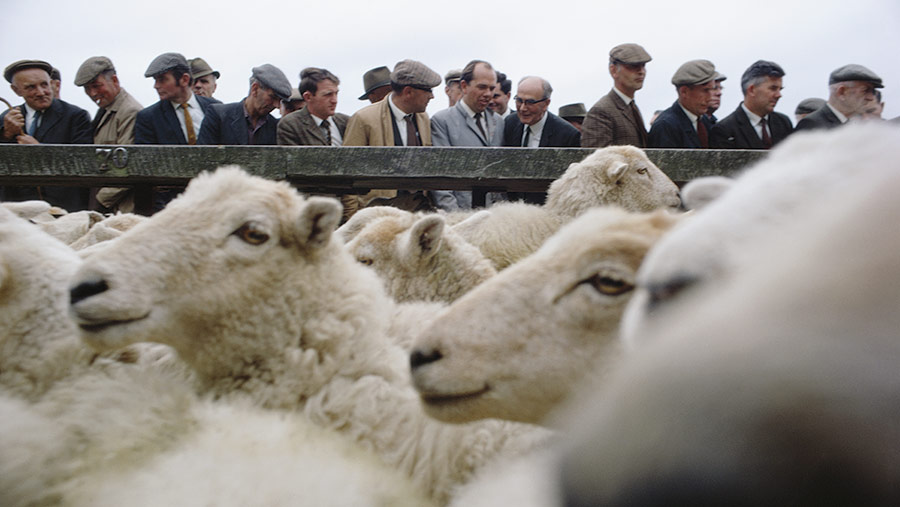Taking Stock looks back on 50 years of farming
 © RDimages/Epics/Getty Images
© RDimages/Epics/Getty Images As part of the Farming Generations theme, this year’s Christmas Taking Stock looks at historic livestock prices.
We consulted with Andersons, the John Nix pocketbook and tractor writer and historian Stuart Gibbard to track changes since 1970.
It seems that farming is harder than ever, in an age of rising costs and falling margins.
See also: Farmers Weekly’s eight decades of farming news
Granted, previous generations often did far more physical work, but the rewards were there for those who worked hard and produced good stock.
Major change has come in the price of wool, fuel, labour and land, with input costs generally tracking much closer to inflation rates than farm goods have done.
Farmers Weekly has reflected on this change. By looking at the turnover generated by a calf, a lamb, a bacon pig and a litre of milk, it is easy to see why profit margins have become squeezed over time.
Prices 1970 v 2020 |
||
|
Commodity |
1970 |
2020 |
|
One week’s farm labour |
£14.80 |
£320.19 |
|
New tractor |
£1,340 |
£62,500 |
|
An acre of land |
£259 |
£10,000 |
|
Tonne of wheat |
£32 |
£150 |
| Notes: Rough costs for tractors are given as a two-wheel drive 60 horsepower tractor in 1970 costing £1,340 (Massey Ferguson 165). In 1980, we have used a two-wheel drive Ford 4000 because 60-70 horsepower tractors were more common then. Prices thereafter are for four-wheel drive 120 horsepower tractors. 2020 prices are averages from 2019 with 3% added inflation. Working week is 42 hours | ||
Changing costs
Farmers have made great strides to increase farm output, but not to the extent of which costs of goods and services have risen, explains Andersons agribusiness analyst Alex Benbow.
In 1978 red diesel averaged 8.42p/litre, which rocketed to 20p/litre by 1982 and has since almost trebled to 56p/litre.
Labour costs are now a major factor, although mechanisation and the rise of contract work has allowed for more efficient use of labour.
Since 2000 the cost of a week’s labour has almost doubled from £170 to £320 and has increased a further 28% since 2010.
What things cost in 1907
- 35p Cost of an hour’s farm labour in 1970
- £30 Cost of a typical commercial shearling ram
- £52.50 The price of a bucket-reared beef-cross calf
- £15.70 Price of a pork pig
Land prices
One area that has changed hugely is land prices. Despite cows giving double the yield of 50 years ago, at an average of 8,000 litres, the rate at which land has increased means it takes almost 15 times more cows to buy a hectare of land today.
In 1970, you needed 1.62 cows giving 4,000 litres a year at 4p/litre to buy a hectare. Now you need 4.31 cows giving 8,000 litres at 29p/litre to buy a hectare.
Wool
Older generations can remember when a large flock’s wool cheque bought a Land Rover or paid the rent. Today, man-made fibres have altered wool’s value beyond all recognition.
In 1970 a fleece averaged £1.40, meaning nine fleeces were needed to pay for a replacement ewe which cost £12.
Today a fleece averages £1 – not covering shearer costs – meaning 140 would need to be sold to buy a lowland replacement ewe for £140.
Inflation over time
If farmgate prices had increased with inflation since 1970, farmers would be receiving 63p/litre for milk and £525 for a tonne of wheat, says Ms Benbow.
She explains that the price of a four-wheel drive 120hp tractor has gone up almost perfectly in line with inflation since the 1970s, although at the time stock farms typically had a tractor of half that power.
“The cost of a tractor is 15 times more expensive in current terms, but the same when inflation is accounted for,” said Ms Benbow.
“A combine is a whopping 25 times more expensive to buy and 1ha of land will cost you 40 times more than if you were buying it 50 years ago.”
